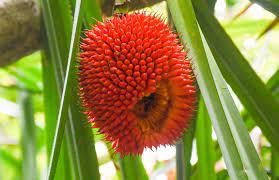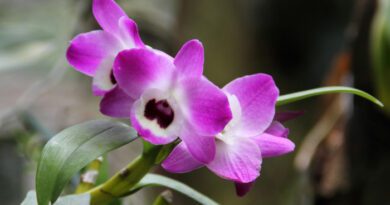18 Medicinal Health Benefits of Screwpine (Pandanus)
Pandanus is a genus of approximately 750 species of perennial plants, often referred to as screw pines. These unique plants are renowned for their long, narrow leaves and intriguing aerial roots. They are predominantly found in tropical regions, with a rich presence in Southeast Asia and the Pacific Islands.
Pandanus is a genus of tropical trees and shrubs that belongs to the family Pandanaceae. These plants are instantly recognizable by their distinctive prop roots, spiky leaves, and pineapple-like fruit clusters.
While there are over 700 species of Pandanus, they share several common characteristics, making them easily identifiable.
Pandanus is commonly found along coastlines, where its prop roots help stabilize sandy soils and prevent erosion.In tropical rainforests, Pandanus species play a vital role in the ecosystem, providing food and shelter to various wildlife.
Anatomy of Screwpine Medicinal Plant
Pandanus plants are characterized by:
1. Prop Roots: One of the most distinguishing features of Pandanus is its prop roots, which extend from the trunk and provide stability in sandy and coastal environments.
2. Spiral Leaf Arrangement: The long, narrow leaves of Pandanus are arranged in a spiral pattern around the branches, giving the plant its unique appearance.
3. Fragrant Flowers: Many Pandanus species produce fragrant, white or cream-colored flowers, adding to their aesthetic appeal.
4. Edible Fruits: Pandanus fruits, often referred to as “Pandanus nuts” or “Screw Pineapples,” are edible and have a sweet, tropical flavor.
Proper Storage of Screwpine Leaves Medicinal Plant
Storing pandanus leaves correctly is essential to preserve their freshness and aroma for an extended period. Here are some tips for proper storage:
1. Damp Cloth Method: To keep pandanus leaves fresh, wrap them in a damp cloth. The moisture helps maintain their green color and prevents them from drying out. Place the wrapped leaves in an airtight container or a resealable plastic bag.
2. Freezing Pandanus Leaves: Another way to store pandanus leaves is by freezing them. Wash and dry the leaves thoroughly, then cut them into smaller sections.
Place these sections in an airtight container or a freezer-safe bag and store them in the freezer. Frozen pandanus leaves can last for several months, allowing you to enjoy their fragrance and flavor year-round.
3. Dried Pandanus Leaves: If you prefer a longer shelf life, you can dry pandanus leaves. Lay them out in a single layer on a baking sheet and leave them in a cool, dry place.
Once they are completely dry, store them in an airtight container. Dried pandanus leaves can be used to make teas or infusions.
Screwpine Medicinal Plant Species Variation
Pandanus is a genus known for its incredible diversity, with over 700 identified species. Each species boasts unique characteristics and adaptations, contributing to the plant’s ecological and cultural significance.
1. Pandanus Utilis: Pandanus utilis, also known as the Screw Pine or Tahitian Screwpine, is one of the most recognizable and widely cultivated species. It is prized for its tall, slender trunk and gracefully arching leaves. This species is often planted for ornamental purposes and used in landscaping projects.
2. Pandanus Amaryllifolius: Pandanus amaryllifolius, commonly referred to as Pandan Leaf, is treasured in Southeast Asian cuisine for its fragrant leaves. These leaves are used to wrap and flavor rice and desserts. Their unique aroma is a hallmark of many dishes in the region.
3. Pandanus Tectorius: Pandanus tectorius, also known as Hala or Screwpine, is renowned for its cultural significance in Hawaii. Its leaves are used in crafting traditional Hawaiian mats, baskets, and thatch roofs. This species highlights the vital connection between Pandanus and indigenous cultures.
The Medicinal Health Benefits of Screwpine (Pandanus)

1. Nutritional Composition: Pandanus leaves are a rich source of vitamins A and C, both of which are essential for maintaining healthy skin and boosting the immune system. Additionally, they contain significant amounts of calcium, potassium, and magnesium, contributing to strong bones and overall vitality.
2. Dietary Fiber: The dietary fiber found in Pandanus leaves and fruit aids in digestion, promotes a feeling of fullness, and helps regulate blood sugar levels. This makes it an excellent choice for individuals looking to manage their weight and improve their digestive health.
3. Antioxidant Properties: One of the standout features of Pandanus is its high antioxidant content. Antioxidants help combat oxidative stress in the body, reducing the risk of chronic diseases including heart disease and cancer and promoting overall well-being.
4. Anti-Inflammatory Effects: The plant’s anti-inflammatory properties are well-documented, making it an ideal natural remedy for conditions like arthritis and inflammatory bowel disease. It can help alleviate pain and discomfort associated with these ailments.
5. Skin Nourishment: Pandanus extract is rich in antioxidants, which can help protect your skin from environmental damage. It is used in various skincare products like creams, serums, and lotions to promote healthy and youthful-looking skin.
6. Blood Sugar Management: Pandanus have a role in blood sugar management. The plant contains compounds that could help stabilize glucose levels. Yet, it is vital to remember that Pandanus alone is not a substitute for diabetes medication or proper dietary management.
7. Skin Hydration: Pandanus is rich in moisturizing properties. You can prepare a Pandanus face mask by blending the leaves into a paste with a bit of water. Applying this mask can help hydrate and rejuvenate your skin.
8. Anti-Aging Benefits: The antioxidants in Pandanus leaves can combat free radicals, which are a major contributor to premature aging. Regular use of Pandanus-infused skincare products may help reduce the appearance of fine lines and wrinkles.
9. Respiratory Health: The leaves of Pandanus are sometimes used to address respiratory issues. Pandanus leaf extracts are believed to have bronchodilatory properties, making them potentially useful for individuals with asthma or other respiratory conditions.
However, it is essential to consult with a healthcare professional before using Pandanus as a remedy for respiratory issues.
10. Weight Management: While Pandanus is not a miracle weight loss solution, it can be a valuable addition to a balanced diet. The fiber content in Pandanus leaves help promote feelings of fullness, which can contribute to better portion control and weight management.
11. Strengthening Hair: Pandanus oil, when massaged into the scalp, can strengthen hair roots and promote hair growth. It is a natural way to address hair loss and maintain healthy locks.
12. Dandruff Control: Pandanus leaves have antimicrobial properties that can help control dandruff. You can make a Pandanus hair rinse by boiling the leaves and using the cooled infusion as a final hair rinse after shampooing.
13. Natural Fragrance: The delightful aroma of Pandanus makes it a popular ingredient in perfumes and scented oils. The fragrance is often associated with relaxation and tranquility, making it a sought-after scent in aromatherapy.
14. Hair Care: Pandanus is also used in hair care products like shampoos and conditioners. Its natural extracts can help nourish and strengthen hair, leaving it shiny and healthy.
15. Boosting Immunity: Pandanus is known to enhance the body’s immune response, thanks to its high vitamin C content. A strong immune system is crucial for warding off infections and illnesses.
16. Digestive Aid: The dietary fiber in Pandanus promotes healthy digestion by preventing constipation and supporting a balanced gut microbiome. It also soothes gastrointestinal discomfort.
17. Pain Relief and Anti-Fever Properties: The plant’s natural compounds have analgesic properties, making it effective for pain relief especially in conditions like arthritis. It also exhibits antipyretic effects, which can help reduce fever.
16. Stress Reduction and Sleep Aid: Pandanus has a calming effect on the nervous system, making it an excellent choice for stress reduction. It can also improve sleep quality, helping you wake up refreshed.
Read Also: 7 Medicinal Health Benefits of Daffodils (Narcissus Plant)
The Methods of Usage to Achieve the Provided Health Benefits of Screwpine (Pandanus)
1. Pandanus Leaves and Extracts: The leaves of the Pandanus plant are the most commonly used part for their health benefits. They can be consumed in various forms, including fresh leaves, extracts, and dried powder.
2. Healing Compress: Pandanus leaves can be used to make a healing compress. Boil a handful of fresh leaves, let them cool slightly, and then apply them to bruises, sprains, or sore muscles.
The leaves’ natural properties can help reduce inflammation and alleviate pain.
3. Pandanus Oil: Pandanus oil, extracted from the leaves, is used in aromatherapy and massage. It is known for its calming properties and can be applied topically to ease stress and tension.
The leaves can also be used to make Pandanus oil, which is known for its soothing effects on the skin. This oil is particularly useful for massages and can help relax muscles and improve blood circulation.
4. Aromatherapy: The distinct aroma of Pandanus leaves can have a calming and stress-relieving effect. Inhaling the scent of Pandanus leaves or using Pandanus essential oil in aromatherapy can help reduce anxiety and promote relaxation.
5. Enhancing Cognitive Function: certain compounds in Pandanus have cognitive-enhancing properties. While more research is needed in this area, adding Pandanus to your diet may support brain health.
6. Pandanus Supplements: For those seeking a convenient option, Pandanus supplements, such as capsules or powders, are available in health food stores. These provide a concentrated dose of Pandanus’s beneficial compounds.
7. Pandanus Cocktails and Mocktails: For a refreshing twist, Pandanus syrup or Pandanus-infused spirits can be used to craft unique cocktails and mocktails. These beverages provide a tropical touch to your gatherings.
8. Pandanus Tea: Pandanus tea is a delightful way to enjoy its benefits. Simply steep a few leaves in hot water for a soothing and fragrant tea that can be enjoyed throughout the day. It is often used to aid digestion, reduce stress, and improve sleep quality.
9. Pandanus-Infused Water: Create a refreshing Pandanus-infused water by placing a few Pandanus leaves in a jug of water and letting it sit for a few hours. This subtly flavored water not only quenches your thirst but also provides a hint of Pandanus goodness.
10. Pandanus-Enhanced Recipes: Pandanus leaves can be used in a variety of culinary applications. They can infuse a unique, aromatic flavor into dishes like rice, curries, and desserts. Pandan-flavored ice cream and Pandanus-infused rice are particularly popular.
11. Pandanus in Cooking: Pandanus leaves, often referred to as “Pandan leaves,” are known for their sweet, nutty, and slightly floral aroma. They are a staple in many Southeast Asian cuisines.
One of the most common culinary uses is in rice dishes, where Pandanus leaves are tied into knots and added to the rice cooker. This imparts a delightful fragrance to the rice.
12. Desserts and Sweets: Pandanus leaves are frequently used to infuse desserts and sweets with their distinct flavor. Pandanus extract can be added to custards, puddings, and cakes, giving them a unique tropical twist.
It is particularly popular in kueh (traditional cakes) in Southeast Asia.
13. Beverages: Pandanus leaves are also used to make refreshing beverages. Pandanus tea, made by infusing Pandanus leaves in hot water, is not only soothing but also aromatic. It can be enjoyed hot or cold and is often sweetened with honey or sugar.
Read Also: Pests of Stored Products and Damages Caused
The Side Effects of Using Screwpine Medicinal Plant
While Pandanus offers numerous benefits, it is crucial to be aware of its potential side effects, especially when consumed or applied in excess.
1. Gastrointestinal Distress: Consuming an excessive amount of Pandanus leaves or fruit can lead to gastrointestinal discomfort. Some individuals may experience symptoms such as stomach cramps, diarrhea, or nausea.
2. Skin Irritation: Pandanus extracts and oils, when applied topically, can sometimes cause skin irritation or allergic reactions. It’s advisable to perform a patch test before using such products extensively.
3. Allergic Reactions: While Pandanus is generally safe for consumption, some individuals may experience allergic reactions as itching, swelling, or difficulty breathing. It is essential to be cautious if you have a known allergy to Pandanus.
4. Digestive Discomfort: In rare cases, excessive consumption of Pandanus may lead to digestive discomfort such as diarrhea or stomach cramps. Moderation is key when using Pandanus.
Precautions and Recommendations in Using Screwpine Medicinal Plant

1. Dosage and Frequency: To avoid potential side effects, it is important to follow recommended dosage guidelines. Consult with a healthcare professional for personalized advice.
2. Consulting a Healthcare Professional: Before incorporating Pandanus into your healthcare regimen, especially if you have underlying medical conditions or are pregnant, consult with a healthcare professional for guidance.
3. Moderate Consumption: While pandanus is safe when used in moderation, excessive consumption can lead to digestive issues. It is best to follow recommended serving sizes and not overindulge in pandanus-containing dishes or beverages.
4. Patch Test: Before using Pandanus-based skincare products, perform a patch test to ensure you don’t have an adverse skin reaction.
5. Drug Interactions: If you are taking medication for any health condition, consult with a healthcare provider before using Pandanus medicinally. It may interact with certain drugs, potentially affecting their effectiveness.
6. Pregnant and Nursing Women: Pregnant and nursing women should exercise caution when considering Pandanus for medicinal use. Limited research is available on its safety in these situations, so it is best to err on the side of caution.
7. Proper Washing: Before using pandanus leaves in cooking or for medicinal purposes, it is crucial to wash them thoroughly. This helps remove any dirt, pesticides, or contaminants that might be present on the leaves.
8. Source Authenticity: Ensure that you source pandanus leaves from reputable sources. This reduces the risk of contamination and ensures that you are using a genuine product.
FAQs About Screwpine Medicinal Plant
1. Can Pandanus be used by pregnant women?
Pregnant women should consult their healthcare provider before using Pandanus, as individual circumstances may vary.
2. Are there any age restrictions for Pandanus consumption?
Pandanus is generally safe for adults. However, it is advisable to consult with a healthcare professional before giving it to children.
3. Can Pandanus help with skin conditions?
Some people find Pandanus beneficial for certain skin conditions, but results may vary. Consult with a dermatologist for specific skin concerns.
4. Is Pandanus suitable for vegetarians and vegans?
Yes, Pandanus is suitable for vegetarians and vegans, as it is a plant-based product.
5. Where can I purchase Pandanus products?
Pandanus products, such as leaves and extracts, are available in many health food stores and online retailers.
6. Are all Pandanus species edible?
No, while many Pandanus species produce edible fruits, not all of them are suitable for consumption. Some may be toxic.
7. What are some common dishes made with Pandanus fruit?
Pandanus fruit is used in a variety of dishes, including rice cakes, jams, and flavored drinks.
8. Why are Pandanus leaves used in weaving?
Pandanus leaves are flexible and durable, making them ideal for weaving into various handicrafts.
9. How do Pandanus plants adapt to coastal environments?
Pandanus plants develop prop roots that help anchor them in sandy soils, allowing them to thrive in coastal regions.
10. What cultural significance does Pandanus hold in the Pacific Islands?
Pandanus is often used in ceremonies, rituals, and as a symbol of hospitality and friendship in the Pacific Islands.
11. How do you extract Pandanus essence for culinary use?
Pandanus essence is typically obtained by crushing or blending fresh Pandanus leaves and then straining the liquid. It can be used to infuse a delightful aroma into a variety of dishes.
12. What are the different varieties of Pandanus?
There are over 700 species of Pandanus, each with its unique characteristics. Some well-known varieties include Pandanus amaryllifolius and Pandanus tectorius.
13. Is Pandanus used in traditional medicine outside of Asia and the Pacific Islands?
While Pandanus is most commonly associated with Asian and Pacific Island traditional medicine, it is also used in some African and South American healing practices.
14. Are there any conservation organizations dedicated to protecting Pandanus species?
Yes, several conservation organizations and botanic gardens are actively involved in preserving Pandanus species and their habitats. They conduct research, raise awareness, and work on habitat restoration projects.
15. Can I grow Pandanus as a houseplant?
While some Pandanus species can be grown indoors as houseplants, they generally thrive in tropical and subtropical outdoor environments. Be sure to research the specific species and their care requirements before attempting to grow them indoors.
16. What is the significance of Pandanus garlands in Pacific Island cultures?
Pandanus garlands, or ‘lei,’ are symbols of welcome, friendship, and respect. They are commonly exchanged during greetings and celebrations.
17. Are there any traditional rituals associated with Pandanus in Asia?
Yes, in some parts of Asia, Pandanus is used in religious rituals and ceremonies, often associated with purification and devotion.
18. Do Pandanus species have any natural predators?
While some insects and animals may feed on Pandanus leaves and fruits, they are not typically plagued by severe natural predators.
19. What are some other names for Pandanus in different regions?
Pandanus is known by various names worldwide. For example, it is called ‘Screw Pine’ in English, ‘Hala’ in Hawaiian, ‘Daun Pandan’ in Malay, and ‘Bai Toey’ in Thai.
20. How can individuals contribute to Pandanus conservation efforts?
Individuals can support conservation by participating in reforestation programs, raising awareness, and choosing products made sustainably with Pandanus leaves.
Supporting local artisans who craft Pandanus products also helps promote conservation.
Read Also: Relationship Marketing Process and Approaches to the Study of Marketing









